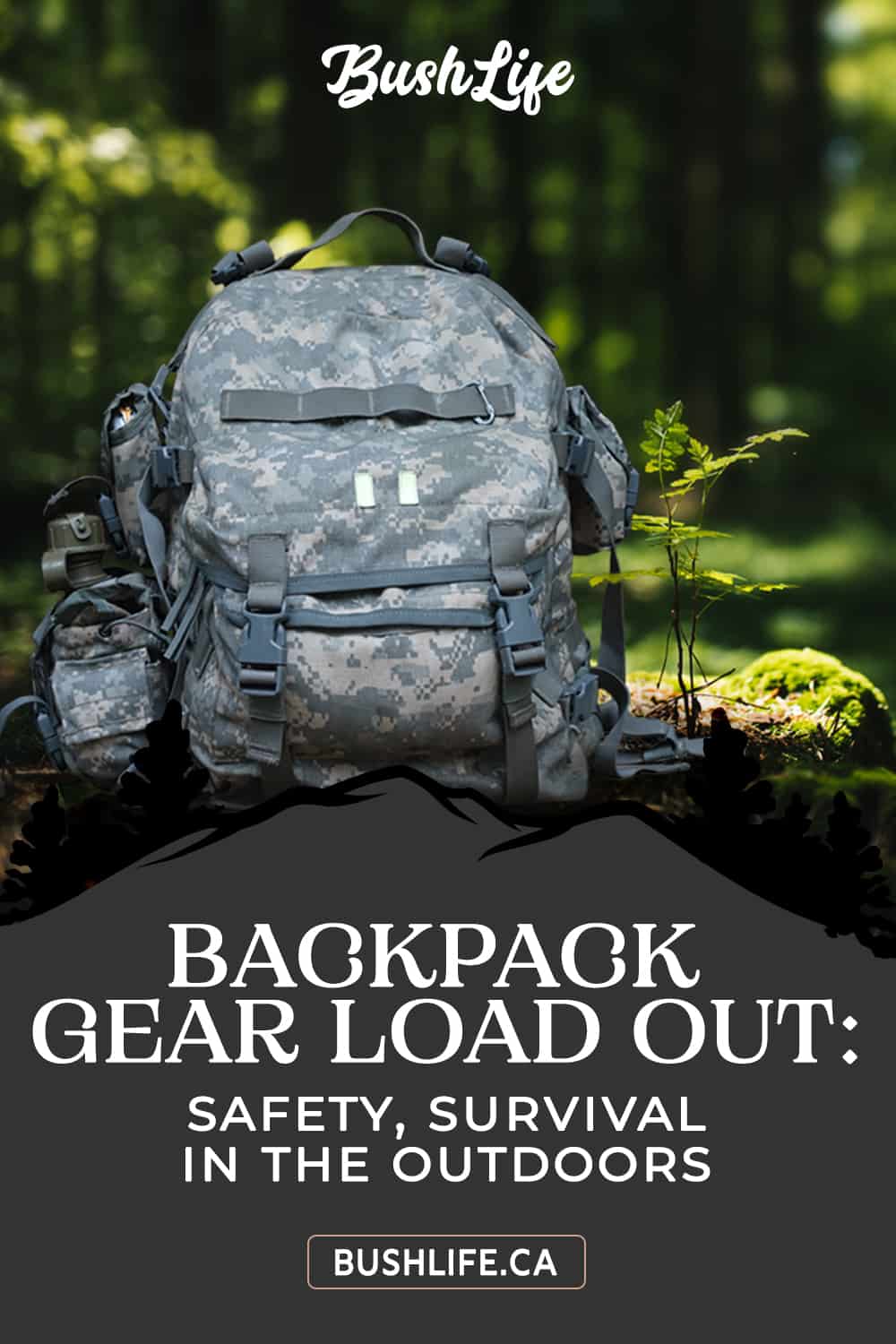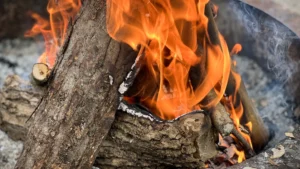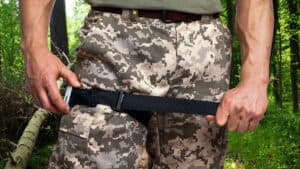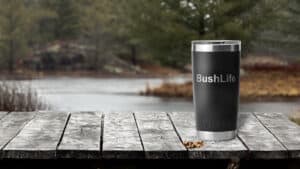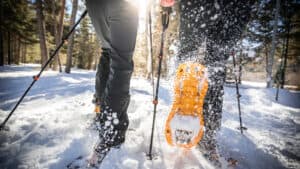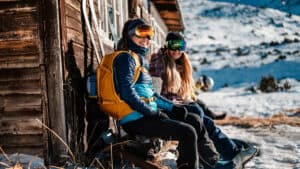What Backpack Survival Gear Do I Need to Enjoy (and Survive) the Outdoors? An outing into the woods requires a backpack and enough survival gear to get you through your adventure. But that same pack should cover at least 24 hours of survival.
And no, before you even think of it, this is not a prepper kind of thing, nor is a forest something to fear. It is simple prudence to have and be confident in your gear and ability to take care of yourself should something go wrong. What serenity provides is solitude, but that works both ways. It means you are on your own out there.
Discloure: Posts may contain affiliate links. Purchases made through our links result in a small commission to us at no charge to you. We only recommend products that meet our brand standards based on testing and first hand use by our authors.
Survival for one day also means setting up camp for one night. Why? Because it is safer and easier to move in the daytime, particularly if you are exhausted, injured or stranded in any way and can not self-rescue.
Ideally, we should aim for a 24-72 hour situation in our outdoor survival pack for those SHTF moments when things seriously go wrong. For the prepper-minded, we are technically putting together what is also known as our ‘bug out bag’ or ‘get home bag’ in this process. But this is more of a perk here than a purpose.
- Weather Complicates What Survival Gear Goes Into a Bug Out Bag
- A Personal Lesson
- The Survival Backpack
- Survival Gear Necessities: Starting With Cutting Tools for Your Bug Out Bag
- Fire Making
- Water Procurement and Treatment Survival Pack Essentials
- Survival Kit Food Items
- Shelter for Your Bug Out Bag
- Navigation
- Survival Signal Kit
- Medical is Another Backpack Survival Gear Must!
- Lighting
- Fishing Survival Kit
- Miscellaneous Backpack Survival Gear Items
- Don’t Forget the Candle
- Survival Pack Content List
- Backpack Survival Gear, Final Thoughts
Weather Complicates What Survival Gear Goes Into a Bug Out Bag
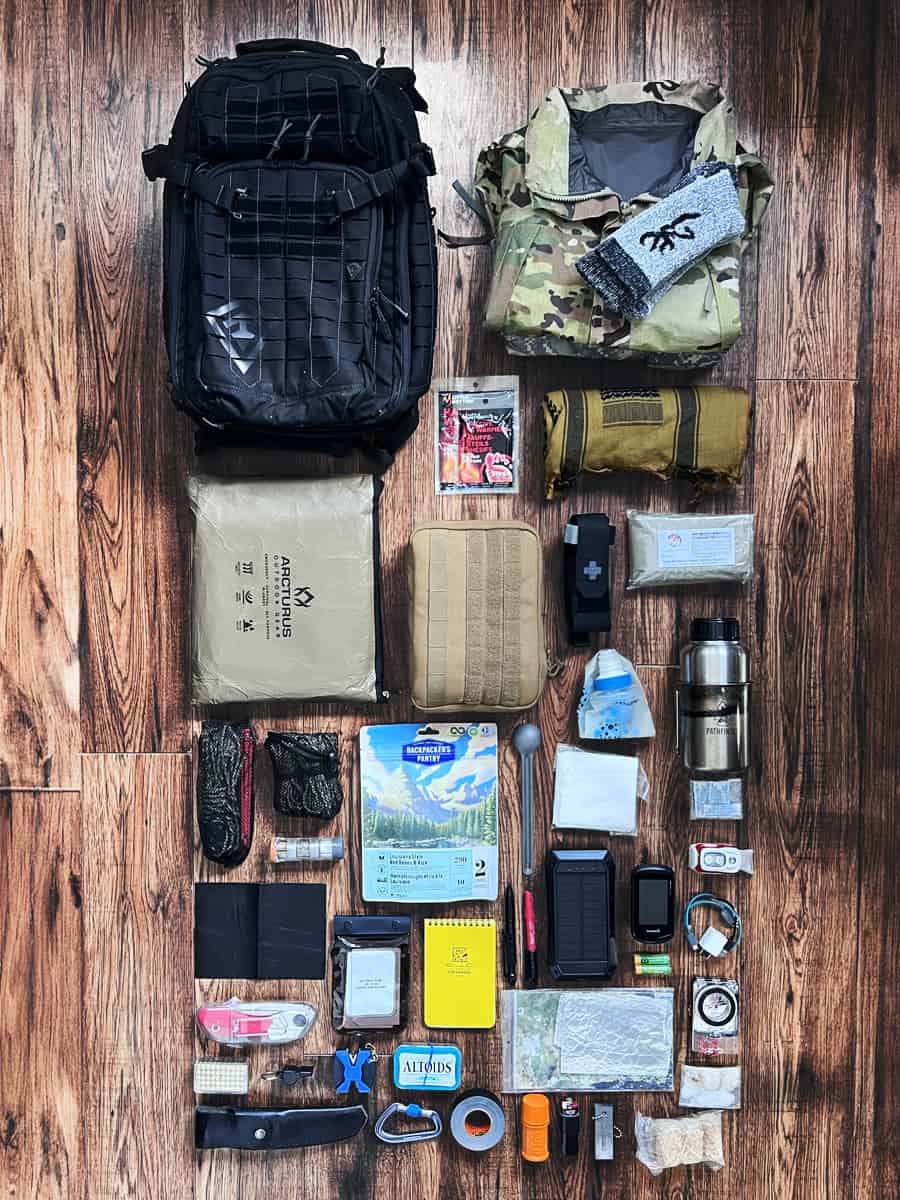
Rain can be misery, but cold weather SERIOUSLY complicates matters with immediate urgency! A cold night means gathering wood and making a fire to stay warm, dry clothes, make safe drinking water, and so on. In a bad situation, we will ask ourselves: do we TRY to leave or stay and set up camp? The truth is, it is one or the other, as gathering a night’s worth of wood takes a long time. Unfortunately, these are decisions we face in a bad situation. These decisions will be made for you if improperly prepared and may lead to a wrong one. The better prepared you are, the more comfortable that night will be.
This post will address what survival pack essentials you need and explain why and how these survival items work together. Even if you are unfamiliar with the outdoors and have no clue where to start, that would be right here!
A Personal Lesson
Before we begin, I want to share a brief story behind the inspiration for this survival pack. Skip this section to get straight to the meat and potatoes.
I bought my first side-by-side in September of 2019. Packed up the family and hit the trails hard with VERY little survival gear, eager to play with the new toy. At least 15 kilometres into the bush, a tree came down and blocked the trail to our only way out. Staring down a wet, muddy trail, a setting sun and the cold chill of fall rolling in, I admit I was more than a little scared. Add a wife and two little kids staring at me, and it turns to desperation. By some miracle, a troop of ATVers came through, and they were more prepared than I was. They removed the fallen tree with the chainsaw they had on hand. A lesson learnt!
With some luck, we managed to avert a bad situation. Luck is unreliable. Since then, there have been multiple complications in the woods, but my bug out bag ALWAYS got me through. While I can not promise something like this will not happen to you, I can show you how to get through it, so stay with me on this post.
Further Reading: The Budget Bug Out Bag that’s Ready to Rumble
The Survival Backpack

Starting with the pack as we need something to carry our survival gear.
The 5.11 Rush 24 2.0 is a fantastic pack. It comes in at 37 litres, which is neither too big nor too small for most activities. It has the most amazing pockets to store gear in an organized fashion, and with tons of MOLLE webbing, it is super easy to expand the pack by bolting on just about anything.
The Rush 24 backpack is designed to hold 24 hours worth of gear, but in the right hands, it will cover 48-72 hours with careful planning. It also takes an absolute beating without showing any signs of wear. The only complaint is the weight, but I guess that is the durability price.
If you are not into the tactical look of the 5.11, no worries, as you have plenty of other options. Brands like Osprey, North Face, Arcteryx, Marmot, Kelty, etc., make excellent commercially available backpacks purpose-built for the outdoors.
In your search, remember that nylon is more durable than polyester, and YKK zippers are a sign of quality. Most importantly, if you intend to carry the pack, it must fit you well! That also means good padding in the shoulder straps and back, not to mention well-positioned sternum and/or hip straps.
Further Reading: 5.11 Rush 24 Backpack Ultimate Review
Survival Gear Necessities: Starting With Cutting Tools for Your Bug Out Bag

Knife
If you ask any outdoorsman: if you could only have one item in the bush, what would it be? The answer is always a knife. It is such a pivotal piece of gear that you should carry a backup knife.
Why? A good knife will have a full tang, which allows you to process wood by batoning (where your knife doubles as an axe). You can use your knife to make tinder by feather sticking. And then, there is the world of bushcraft that opens the doors to making everything from tent stakes, spears, traps and utensils to an entire shelter out of wood and natural materials.
Last but not least, you can cut food, clean game and even hunt with the knife if you are creative enough.
The gold standard for bushcraft is the Morakniv Garberg Carbon, and it’s also, my favourite knife.
The blade is just right in length. With its carbon steel construction and 90-degree spine, it will easily throw a hot shower of sparks from a Ferro rod to get a fire going, and its Scandi grind makes for easy sharpening at home or in the woods. In addition, the Garberg is a full tang and baton-capable blade.
Further Reading: Morakniv Garberg Carbon: What Makes Bushcraft Knives So Special?
Saw
Remember that tree that came down? With no side-by-side or ATV, carrying a chainsaw is not feasible to hike the woods with – a lighter, smaller option is necessary, hence the Silky BigBoy 2000. And no, get your head out of the gutter. Silky is the company, and BigBoy is named accordingly, as it is one of their larger saws. This monster has a 14″ blade, and thanks to how it folds up, it fits nicely into your backpack!
The Silky BigBoy 2000 will process wood with ease. It saved my ass more than once when clearing fallen trees off the road. And yes, there is a recurring theme here with trees. It happens more than you know in rural areas, which is precisely why the bigger saw is preferred, unlike the typical backpack gear setups with smaller saws like the PocketBoy.
Further Reading: Silky BIGBOY: Why A Saw Beats an Axe Every Time
When it comes to utility, a saw is handier than an axe as it processes firewood much faster. Couple this with a full-tang Morakniv Garberg knife, which can further baton the pieces of wood, and there is no need to haul an axe. Not to mention, the Silky BigBoy only weighs 1 lb.
Multi-Tool
A multi-tool is another backpack survival gear item to carry into the woods. Encompassed in this one tool are pliers, screwdrivers, a can/bottle opener, scissors, files, and so on. Of course, it is also a cutting tool, providing you with a spare knife and saw, which is excellent for smaller tasks.
The preference here is the Leatherman Charge + TTi, a family favourite and Leatherman’s flagship model made of premium materials.
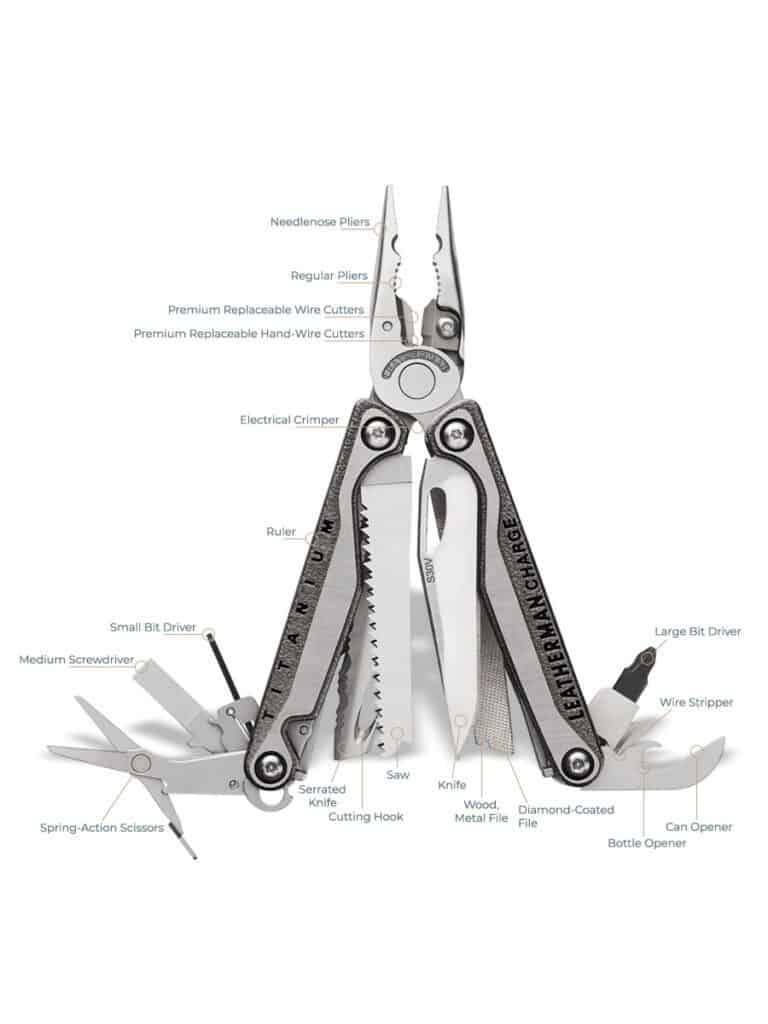
Just like your knife, you should carry the multi-tool on your belt. Being so small and of such great utility, it is worth having this on your personal layer versus the pack layer. My Leatherman Charge is part of my EDC!
Further Reading: Leatherman Charge + TTi: Say Hello to My Little Friend
The sheath has a slot for extra screwdriver bits that come with the tool. The big tip here is to sneak a mid-sized Ferro rod into one of the two available side loops of the sheath.
If you get where I am going with this, you will have a knife, multi-tool, fire-tool and thanks to the tape, some tinder, gear repair and even medical options on your person at all times. This collection becomes a little survival kit!
Fire Making
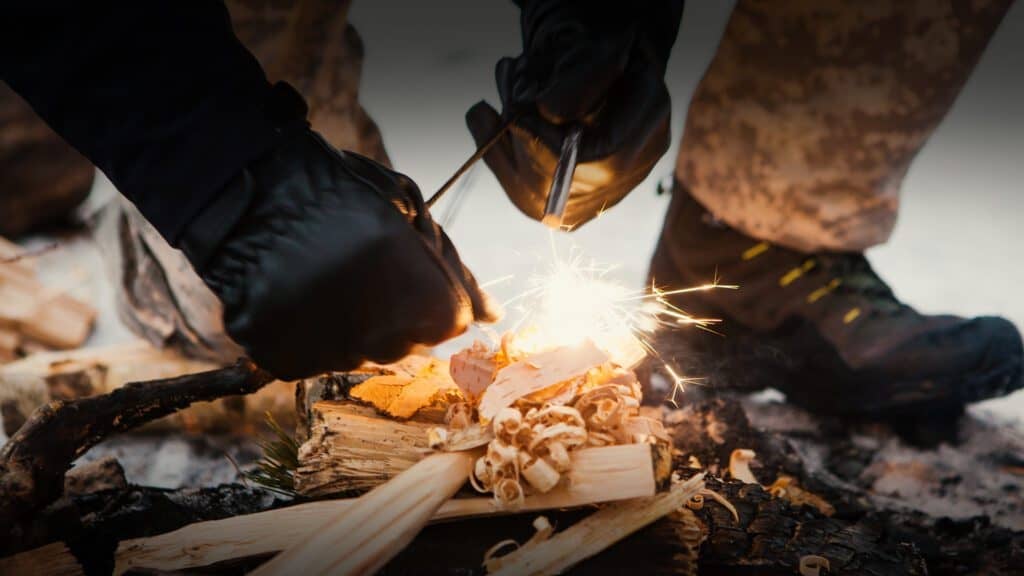
Fire-making is a vital skill in the woods. From providing warmth, drying clothes, sterilizing water, and cooking food, it is a skill that can save your life. If you do not already know it, practice and learn it now! You can even make a fire in the snow.
Once you master different ways to start a fire, follow this simple rule: make fire the most efficient way possible. For that, you can not beat a lighter and Bic is yet another gold standard – it is also cheap as dirt. Carry one in your pocket and in your survival fire kit that should be in your bug out bag.
Get 20% off your TACAMO 15-Piece Emergency Fire Kit, with our exclusive code ‘DT-23W1UOC3’.
What is a Survival Fire Kit?
Your outdoor survival pack is more useful when using pouches, stuff sacks, tins, etc. Each survival kit should be organized by use, such as fire, cooking, medical, etc. It makes it easy for quick and organized retrieval of gear. For example, my fire kit is a soft leather pouch from a local native reserve.
Fire Kit Contents
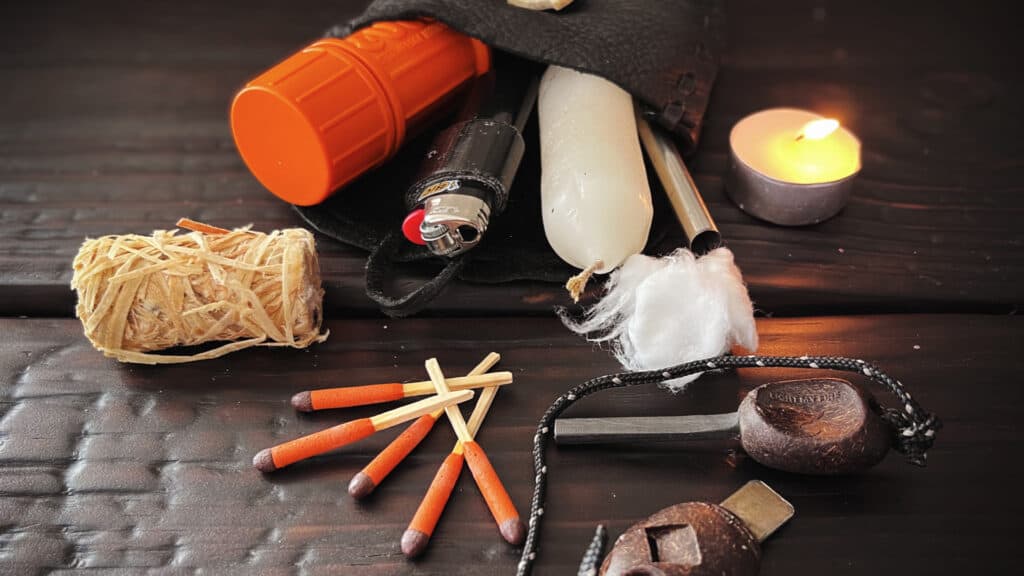
- Bic lighter wrapped with gorilla tape: the tape makes great tinder and doubles as a resource to repair clothing and gear.
- Emergency candle(s)
- UCO waterproof matches in a sealed container
- Ferro rod with striker
- Vaseline-soaked cotton balls in a zip lock or tin: with a Ferro rod, the vaseline/cotton ball mixture lights easily and burns for a long time.
- Some dry tinder in a ziplock (birch bark, cattails, etc.)
- Stainless steel straw. It makes a worldly difference when blowing air into a fire to help it along.
The general rule of thumb is to carry at least 3 ignition sources! An absolute must for any backpack gear load out.
In the colder months, your hands are cold, leaving your gross motor function undesirable. We suggest you opt for a large Ferro rod versus its smaller counterpart. The large rod is easier to work with and may save your life. Imagine falling into an icy lake or river, coming out and then trying to spark a mini Ferro rod with frozen fingers.
The Ferro rod is the fire-making workhorse of the woods, and it NEVER fails. Practice and learn how to use a Ferro rod properly – do not leave it to chance to figure it out when a dire situation occurs.
Further Reading: 7 Fire Kit Survival Essentials That You Should Carry
Bic Lighter Myths
The Bic lighter gets a bad wrap, but it is a myth. Let’s look at a couple of these myths.
Myth #1: The Bic Lighter does not work in the cold! Sure it does. Carry it in an inside pocket. Your body heat will keep the gas warm.
Myth #2: The Bic does not work if submerged in water. While it is true, it is not difficult to resolve. Blowing on it intensely for a minute or two will get it going again, especially if you remove the child safety tab.
Water Procurement and Treatment Survival Pack Essentials
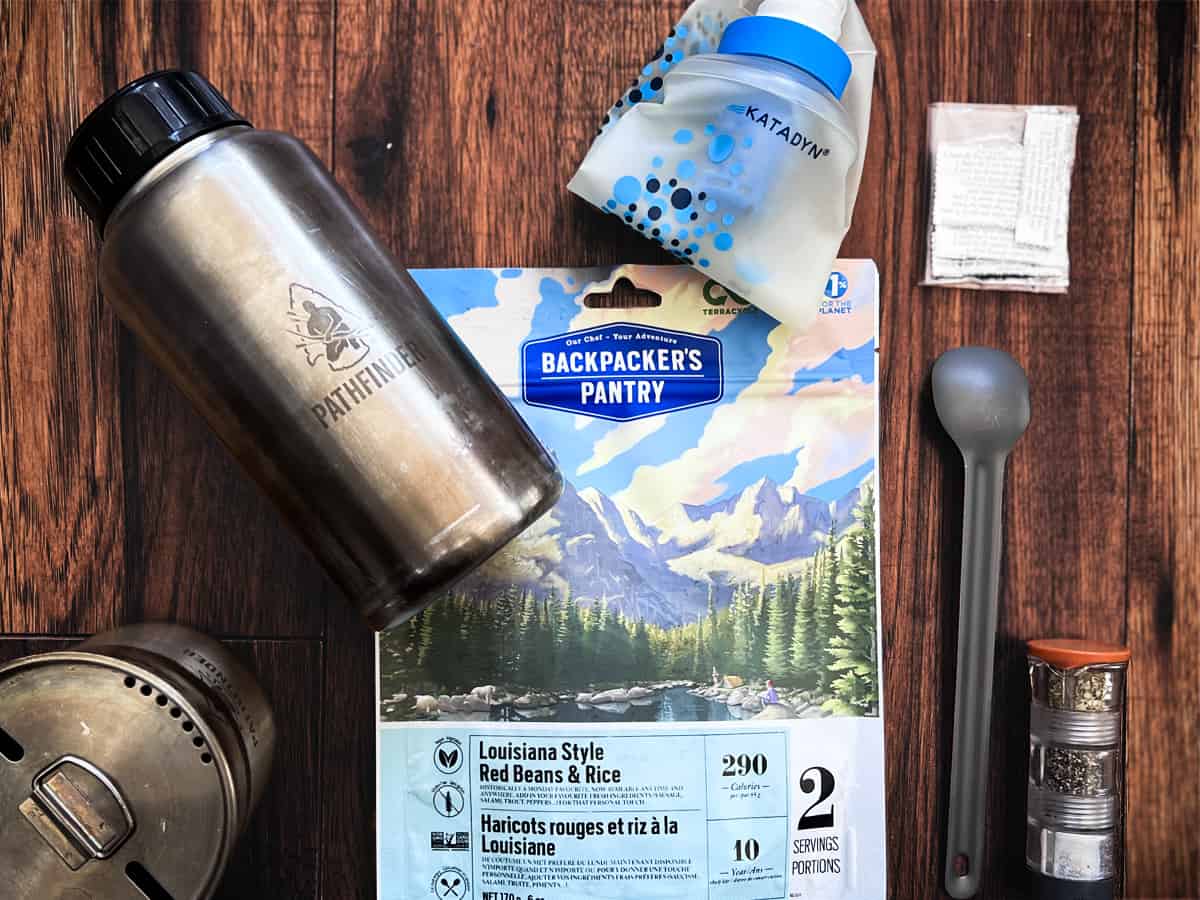
The Priorities of Survival
Water is vital, but we have been saying that throughout the post. So, let us address the priorities of survival. Medical always comes first, and you need to deal with life threats before anything else. It does not matter how much water you have if you are bleeding out. Then comes fire in a cold climate to keep you warm, and let us couple that with shelter so you are warm and dry! Next is water, as you will only survive for up to three days without it.
Drink contaminated water, and you are in for a different world of hurt. Water first needs filtration, and a cotton bandana draped over a container does wonders with this task. Water then needs to be sterilized, which means chemical or boiling.
The All Important Metal Container
A military surplus plastic canteen is fantastic for carrying clean water. It nests into an open-top stainless container for storage. Use the stainless container to collect water, which then gets placed into the fire for sterilization. It doubles as a pot for cooking food, and you can find these easily in surplus stores on the cheap.
The Pathfinder nesting bottle/cup set is ideal as it’s stainless steel, thus allowing for more water volume when boiling. This set is a little more sophisticated, backpack-friendly, and somewhat expensive, but it is well worth it.
Following the pattern, a metal pot of some form is a MUST, and it has to be of single-wall construction. Ie. Not insulated and not a thermos. Insulated or double-wall containers will not allow you to boil water.
Both the military and the Pathfinder pots mentioned above have fold-out handles that facilitate putting them into an open fire and fold back for compact storage.
All-in-One Water Filter
Nowadays, a good water filter will filter and sterilize in one step. Not to mention, provide an extra container to store and transport water. A couple of recommended filters are the Katadyn BeFree or the Grayl Geopress water filter. We use both and have not encountered any issues.
If you are remotely serious about spending time in the great outdoors, you need a filter as a part of your backpack gear. The Geopress is a large and faster water filter, but the BeFree is lighter and takes up less space.
There is one caveat. The water filter in the warmer months is fantastic when water is abundant – and our hydration desires are considerable. We say desires as it is a response to thirst. You typically NEED just as much in the winter. However, in the winter, we are more interested in melting snow. If you have not guessed it, that means back to a metal pot! Taking the filter out in winter also provides extra room for bulkier winter items like extra thick socks, gloves, etc.
Survival Kit Food Items
An MRE is a must survival item to tuck into your get home bag. It is a survival pack, after all. The MRE provides a significant baseline for anything else we add to the food department. With a long shelf life, you need not worry about it expiring. Learn more about MREs here.
The Sustainment Pouch
Once we get into an outing, it is nice to pack an extra day’s worth of food just in case anything goes wrong. Space should not be an issue, provided you have a backpack with built-in MOLLE webbing, which allows you to bolt on a smaller food bag. For that, I use one or two 7-litre military sustainment pouches.
These are simple one-pocket pouches that attach via MOLLE straps. That also means they separate easily to facilitate hanging them in a tree for bear safety during the warmer months. All you need is some paracord.
Snacks or Short Trips
There are times when we are not looking to cook meals. Maybe it is a day hike or an outing to the hunt camp. In these cases, look for calorie-dense items. Some favourites here are a stick of salami, jerky, canned tuna, individually wrapped oatmeal cookies, nuts and any of the million iterations of bars out there. Admittedly, I always carry a Mr. Noodles as it is a great comfort food for the outdoors. Don’t forget to add some energy drink powders.
Between snacks and quality MREs, it is easy to pull off a day or two in a justly light manner, even without refrigeration.
Food and Survival
For the record, food is NOT an immediate survival priority! You can go anywhere from 1 – 3 months without food! It does, however, help immensely with mental well-being, general comfort, and stamina. The big one here is thermal regulation. Being fed will help you stay warm and give you the energy to keep moving forward in those colder months.
Knowing that there is an emergency food pouch in your wilderness survival pack is peace of mind. It is a cheap insurance policy. If kids are involved in your life, I do not see this as optional.
Other Food-Related Items
There are a few other items to add, the big one being a long-handle spoon. MREs are consumed straight out of the bag. The long handle keeps your hands clean.
We also include an Opinel fillet knife dedicated to food preparation. In a survival situation, we can procure fish and will want to preserve every ounce.
Lastly, we have a tiny salt/pepper/oregano shaker. Technically, it is a useless survival item, but if it is potentially my last supper, it better be a good one:)
Shelter for Your Bug Out Bag

Your clothing is your first layer of shelter. It is astonishing how often this is left unnoticed. Dress appropriately for the weather, and for the sake of time, we will leave that to common sense for the most part. Make sure you add an extra set of clothes, which includes socks and rain gear. Keep the bulk to a minimum! You can dry your clothes by the fire while you wear the other.
One item worth mentioning here is Fjallraven Keb pants (click to read the full review). It is what I wear every time I go in the bush. These Keb pants happen to be bug-free and purpose-built for the outdoors. With a base layer, they will even suffice on many a cold day, just not the harsh ones that call for dedicated winter gear.
In warmer months, I will pack a light pair of leather gloves. You will be amazed at how easy it is to trash your hands when processing dry or rough wood. When you are in the bush, the last thing you want are problems with your hands or feet.
Something to Sleep Under
For shelter, I like the military poncho. The rain poncho is protection from the rain while on the move, and it keeps your pack dry as well, which is vitally important. For bunkering down or spending a night in an emergency, it doubles as a tarp. Sometimes, I will sub in an actual tarp, but to be honest, the rain poncho is the general go-to. With it goes a rapid deploy ridge line and some tent stakes, meaning we can have cover from the elements within minutes. And no, we do not need a tent to survive a night in a forest!
On this topic, let us not forget cordage. Always carry some hanks of 550 paracord. It is yet another vital piece of gear that has a million uses.
Now, we also need something to sleep on. To save space and weight, you can carry a large garbage bag, and you have yourself a sleeping pad. Fill the garbage bag with leaves or cedar bows, which creates a browse bed. The cold penetrates from the ground – the makeshift bed will get you off the ground and out of a bind. The trash bag weighs almost nothing and hardly takes any room in your survival pack. Sub the trash bag for a sleeping pad if you are backcountry camping or toting a large-sized backpack.
For warmer days, your bug out bag will have the trusty military poncho liner for something to sleep with. In other words, a light blanket. Unfortunately, a winter sleeping bag is bulky and does not fit. So we carry that separately when mechanized and deeper into the woods.
The Emergency Blanket
I have a love-hate relationship with emergency blankets. If people relied on them for warmth, there was a good chance they would die. What can you possibly expect from a paper-thin piece of plastic? A real blanket is a blanket for a reason, and there is no way around insulation bearing a particular size and weight.
Wrap yourself tight in the emergency blanket, and you will trap some heat thanks to its reflective properties – but you will also trap a lot of moisture from your body, just like a horrible raincoat. You will find yourself cold and wet, which is deadly. There is a way to use these properly, which you can read about here. You will not like the outcome as it is not pretty.
The military-issued emergency blanket has been utilized in the heat of the desert. Why? With enough loss of blood, it is hard to maintain core body temperature. These blankets have their time and place, and I found and carry a well-crafted, quality blanket. It hardly takes space, has little weight, and is strong enough to double as a tarp or makeshift stretcher. I am not naive to think I will wrap myself in it and survive a cold winter night.
Navigation
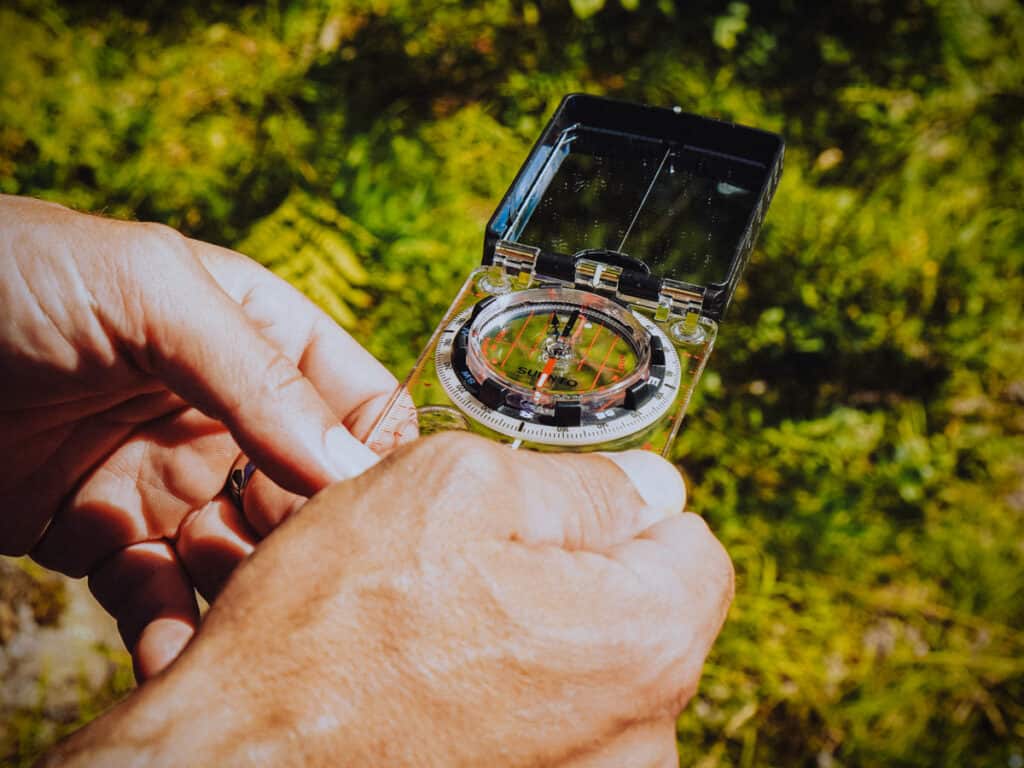
My land navigation kit consists of a map of the local area and a compass. When buying a compass, you know you have a good one when it locks on north quickly and is stable. You can learn about land navigation here.
I used to carry the Suunto A-30. Suunto makes excellent compasses, and they lock onto the north with ease. The A-30 has luminescent markings, making it easy to read in low-light conditions. It is made in Finland and comes with a lifetime warranty.
As an update, I just bought the Suunto MC-2, which is quite the upgrade. It comes with a mirror for signalling and a v-notch for sighting. More importantly, it has adjustable declination and is worth the extra money.
The A-30 has found a new home in my hunting possibles pouch for those times when we want to be minimalistic – it’s a fantastic option for someone starting on a budget.
Both compasses have an NSN number, which means Nato Stock Number. In other words, it’s used by the military and built to strict standards. Don’t fall for all the “mil-spec” trash on the market. The real deal always has an NSN number and has earned the right to be a genuine issue.
Lastly, we carry a Garmin Rhino 750t GPS and a charging cable to go with it.
Survival Signal Kit
A Fox 40 whistle is attached to one of my backpack’s shoulder straps. This way, the whistle is always available as I go through the bush. If hunting, the gun doubles as a sound signalling device. The distance the sound can travel varies on many factors, but up to 2 miles is a real possibility.
Signal mirrors have worked as far as 160 km (100 miles). It is a pretty impressive figure for such a simple device, but not expected under normal circumstances. The mirror also doubles as a tool to see your face or other non-visible body parts in case you need medical attention.
Add to your signalling kit a bright orange cloth or fabric. Failing that, the foil side of the emergency blanket works just as well. Similarly, some flagging tape can come in handy to mark anything from a practical spot to an entire trail.
As an improvised visual signal, your best method is a smokey signal fire. Stay ready by keeping a big batch of green leafy branches close to you and ready to toss onto the fire. Of course, this is when a rescue plane is underway. Or you are trying to get the attention of one.
Medical is Another Backpack Survival Gear Must!
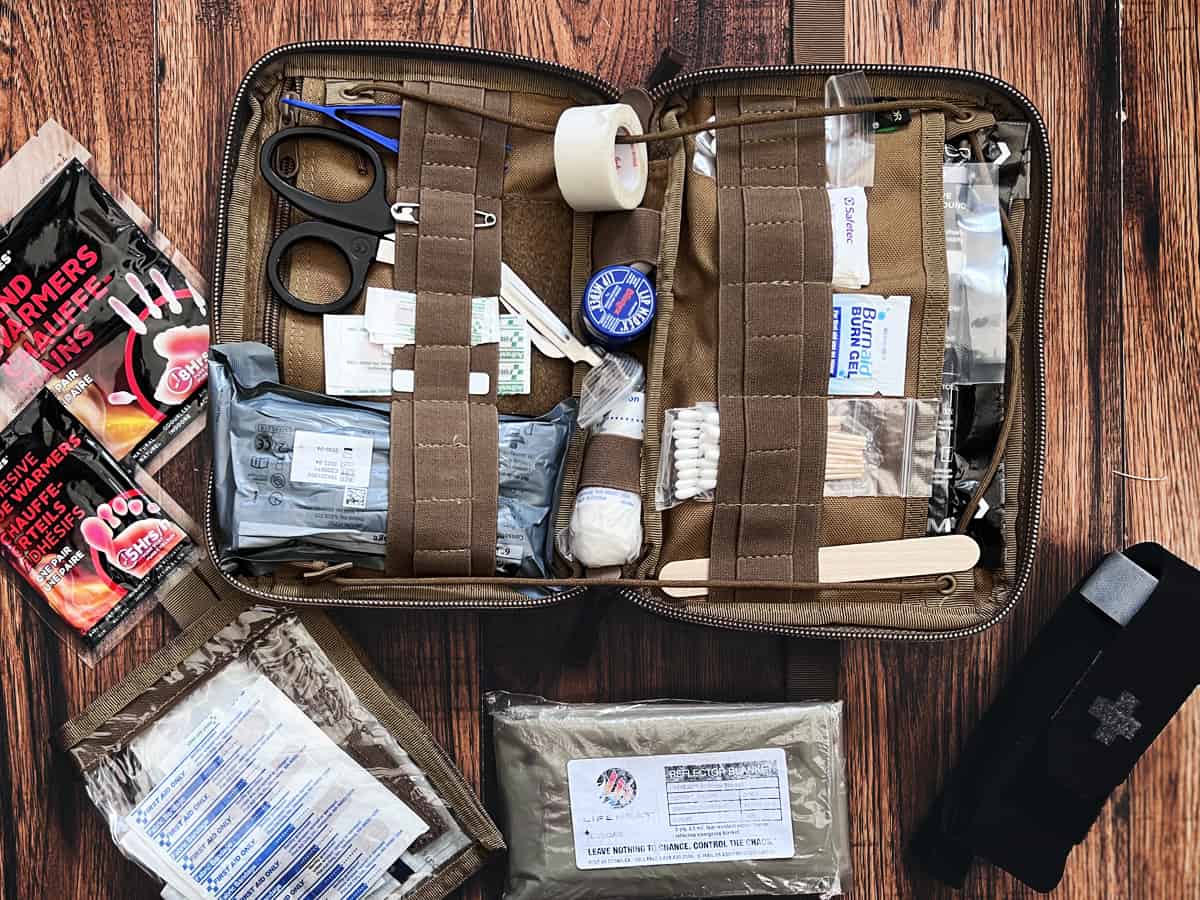
There are endless pre-packaged first aid kits available on the market, not something we’ll go into details on other than carrying one. A better kit comes in a waterproof container, which helps protect its contents.
From time to time, check through yours for expired or damaged items and know what you have on you at all times. I tucked a few extras into mine, such as a small tube of sunscreen, lip balm and bug spray.
The latest addition for me is a CAT tourniquet in blaze orange or whatever is available as CAT tourniquets can be hard to come by. When you need a tourniquet, you will need it immediately and having it stand out in the pack is not a bad idea!
Further Reading: Time To Secure Survival with a CAT Tourniquet
We have an entire post dedicated to the emergency medical kit. By emergency medical, we aren’t referring to the cute and cuddly band-aid packs. Instead, we are thinking about consequential injuries and trauma, which require items like a tourniquet. We’ll leave it at that, with a reminder: if you carry a tourniquet, be sure to carry a Sharpie! You need to mark the time of application for when you receive proper medical care.
It’s also not a bad idea to add an antibiotic kit to your survival pack like the one from Jase Medical. Jase Medical was kind enough to offer our readers $10 off with promo code Bushlife10.
Lighting
The bush on a pitch-black night without light is not a fun place to be. You know, the nights when you can’t even see your hands! That’s especially true when you are not there by choice.
The number one item you want here is a headlamp, as it keeps your hands free to repair gear, prepare food or do chores around camp. I like the Petzl Swift RL. At up to 900 lumens, it provides plenty of light. It’s rechargeable via micro USB, and there are no batteries to fiddle with. I have to admit, it’s also fun showing off its automatic brightness mode with my gearhead buddies!
I also LOVE my BioLite PowerLite. It’s a small lantern. It lights up a decent area and lasts up to 75 hours on low. On high, it fills a room with light. It also doubles as a torch for when distance is an issue. Finally, at 4400 mAh, it provides a battery bank to charge other devices, such as a phone. I believe it’s discontinued, which is too bad as it’s one of my favourite pieces of gear.
Fishing Survival Kit
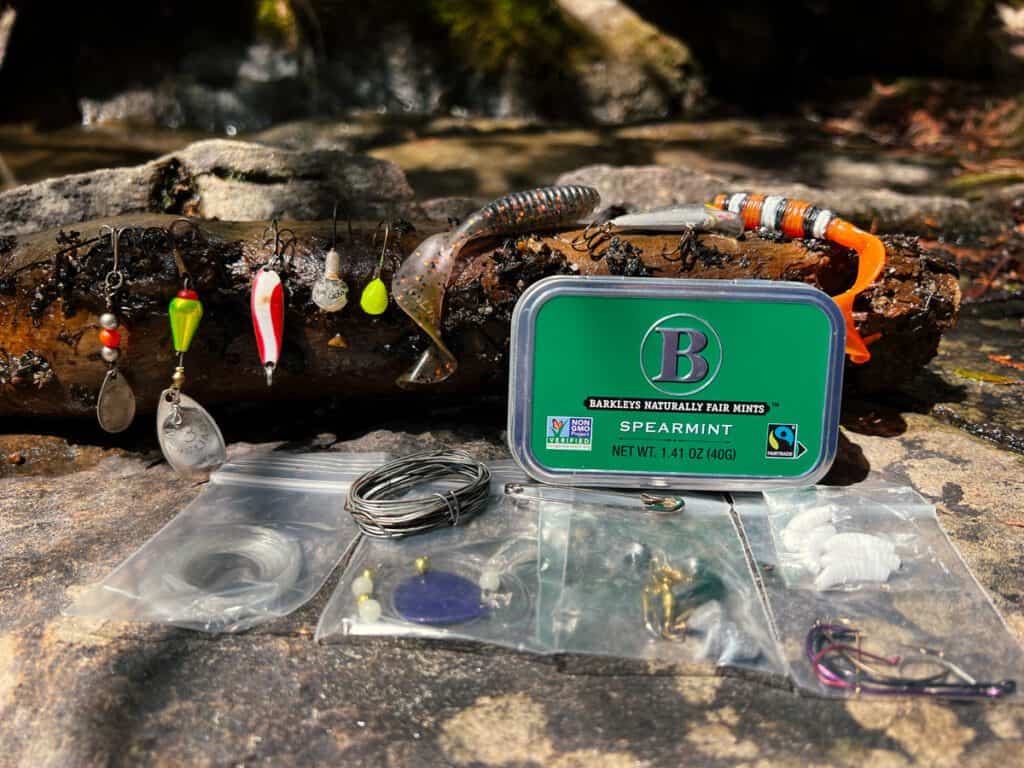
Here, we have a re-purposed Sucrets-style tin. This one so happens to be Barkleys, but that’s beside the point. In it, we have fishing lines, various lures, sinkers, etc. It is a super basic kit for survival purposes, and by no means do we need a rod and reel to fish. There is also some thin metal wire to set wire snare traps. Below is a quick video on how to make a snare trap with a multi-tool.
This emergency fishing tin is my homemade creation, which you can make yourself. The idea here is to have a means to procure food from a small survival kit. You won’t notice it in your pack, and it’s well worth carrying!
Miscellaneous Backpack Survival Gear Items
My maps are in a zip lock to protect them from the elements. Within this same zip lock is a folded piece of tin foil – for which there are a million uses. I also carry a small piece of leather, which you can use as a work surface in the bush. A separate zip lock houses some folded toilet paper. Unless you like wiping with leaves, don’t forget the TP!
Next, we have a Rite in the Rain Notepad, pencil and tactical pen. A notepad and pencil should be in every backpack gear load out! Rite in the Rain makes various waterproof notebooks and weatherproof pens, for which we have a full review. For taking notes, directions, leaving messages and so on. It’s a far more practical piece of backpack gear than we realize.
In my pack, you will also find a high-capacity ABFOCE battery bank and Apple Lighting, micro USB and USB C charging cables for all electronic devices.
In the side pocket, we have that cotton bandana we mentioned in the water section for filtration. The bandana doubles for washing dishing, ourselves, a makeshift sling, making char cloth and whatever else we can think of.
We also carry a roll of 1″ Gorilla tape. Before I forget, there’s a cotton shemagh in the main pouch, which does everything the bandana does but is bigger and better. We can wrap our head to stay out of the sun, wrap our neck for warmth or even use it as camouflage.
In warmer months, we sneak in some bug deterrents and a tiny bottle of dish soap.
Don’t Forget the Candle
Finally, I often carry a UCO candle lantern. These are fantastic as they come with their container, which you can hang or set down. As the candle burns down, the mechanism inside the lantern pushes the candle up to provide you with a constant, steady light.
Remember to add a couple of extra candles to your get home bag. Do not use standard candles – their burn time is significantly less than the emergency variety. Candles like UCO’s burn for 9 hours – look for candles that burn for a minimum of 6 hours.
The candle is a flame extender and the last complement to the fire kit. You can start a fire with wet wood, use it as lighting or help warm up. You can place foil around the candle and increase the lighting output of the candle. When the electronics break or the batteries die, I’m going old school!
Survival Pack Content List
- backpack
- pouches
- knife
- saw
- multi-tool
- fire survival kit (waterproof matches, emergency candles, tinder, Vaseline-soaked cotton ball, lighter, Ferro rod with striker, stainless steel straw)
- stainless steel nesting bottle/cup set
- water filter
- sustenance kit (MREs, snacks, energy drink powder, fillet knife, long spoon)
- extra set of clothes (+ base layer, socks, rain poncho)
- leather gloves (warmer months)
- tarp (550 paracord, #36 bank line, tent stakes)
- garbage bag
- sleeping pad, sleeping bag (if carrying a large backpack)
- emergency blanket
- navigation kit (map, compass, GPS)
- signal kit (whistle, signal mirrors, bright orange cloth)
- medical kit (first aid kit, tourniquet, basic trauma kit, antibiotic kit, sunscreen, lip balm, bug spray, Sharpie)
- headlamp, flashlight
- power bank, charging cables
- waterproof notepad and pen
- cotton bandana, cotton shemagh
- fishing kit (fishing lines, lures, sinkers, snare wire, hooks, spinners, safety pin, weights)
- duct tape
- aluminum foil
- toilet paper (not a roll)
- piece of leather
- candle lantern
Backpack Survival Gear, Final Thoughts
In conclusion, having a well-prepared survival backpack is essential for anyone planning to spend time outdoors. It’s not just about being a prepper or fearing the worst; it’s about being prudent and confident in your ability to self-rescue in an emergency.
From selecting the right backpack to packing the essential cutting tools, this post has covered everything you need to know to create a perfect bug-out bag. So, whether you’re a seasoned outdoorsman or a newbie, take some time to prepare your survival backpack, and you’ll be ready for anything nature throws your way.
And remember, the survival gear in your bug out bag is only as good as your ability to use it! Don’t wait until you’re in a survival situation to learn to use something like a Ferro rod. Practice, practice, practice!
If you found this Backpack Survival Gear guide helpful, share it with your friends who might be interested in survival gear.
Bookmark this post on Pinterest for future reference!
